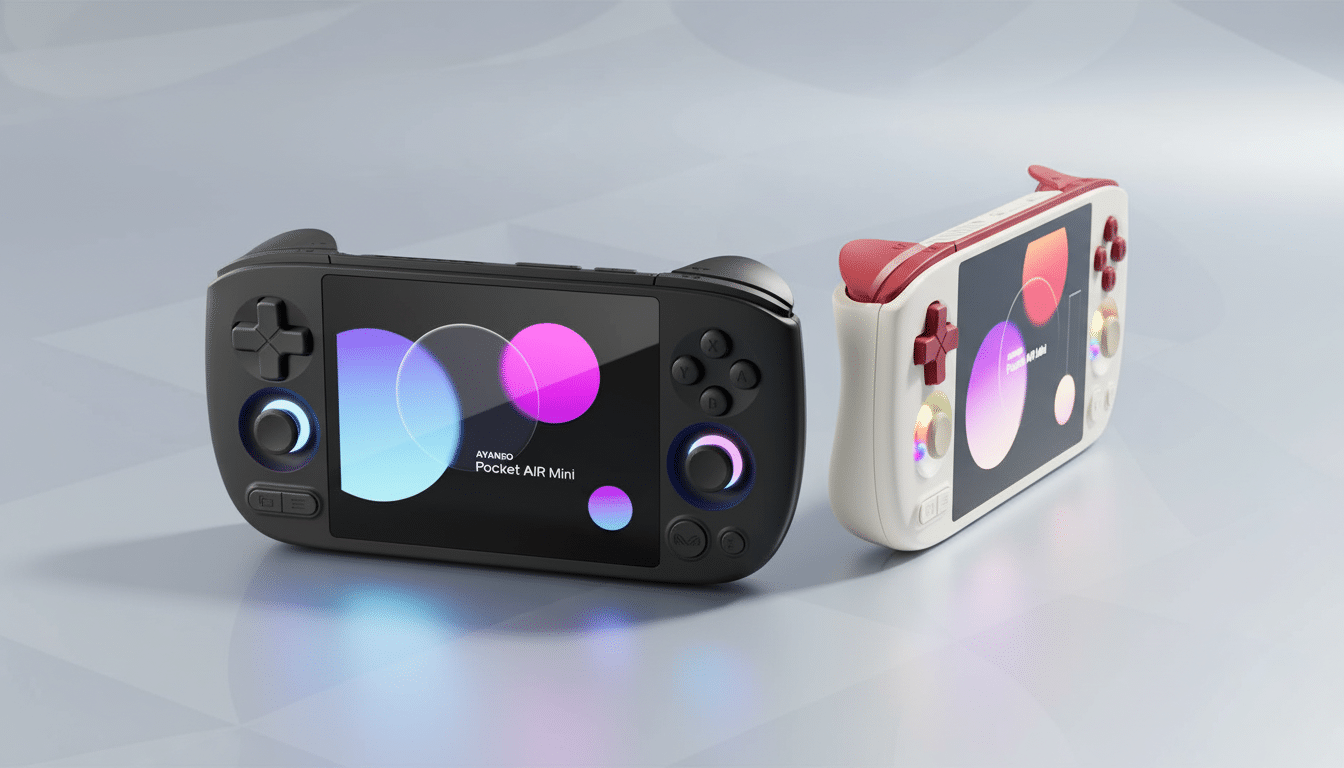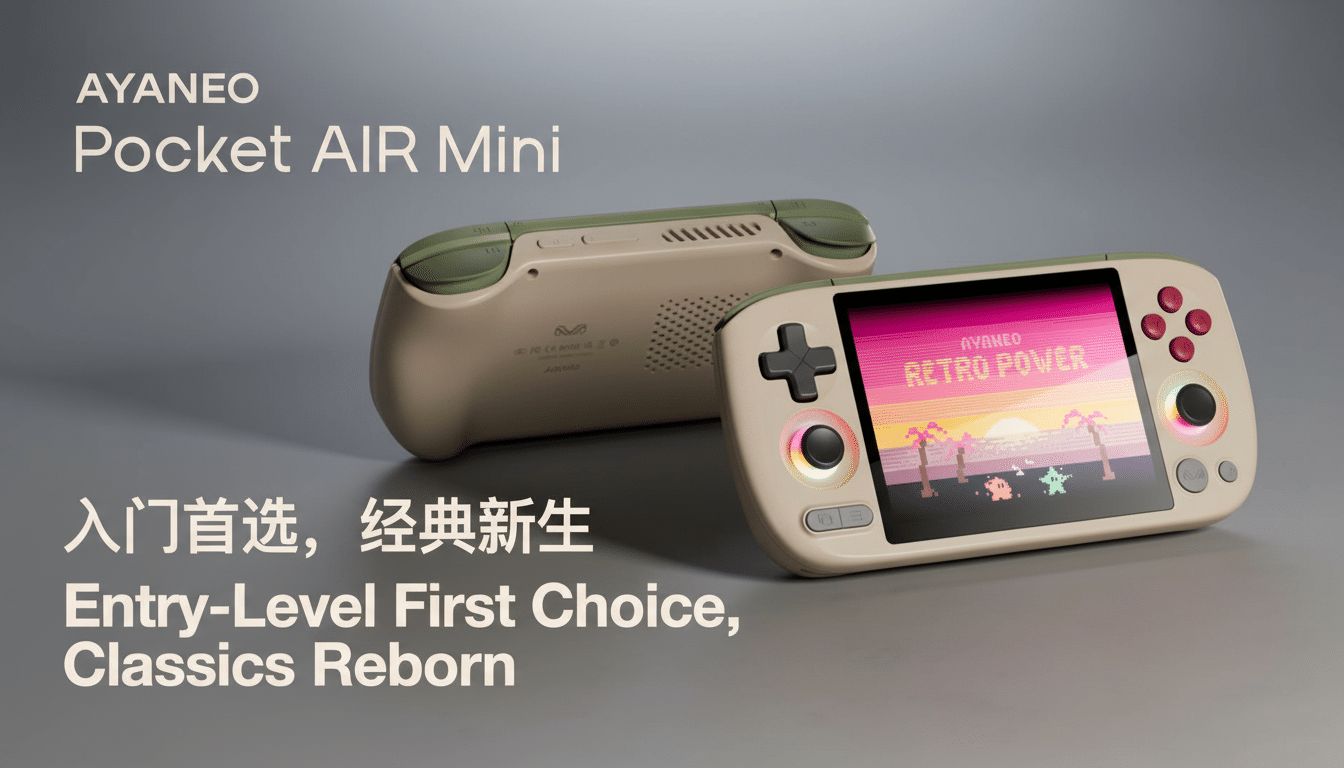The Pocket AIR Mini looks set to redefine budget handheld gaming by coming with a comparably small 4.2-inch display as well as a target price that undercuts much of the Android lot out there. This entry-level model, from early details and company statements, appears to be an effort to bring old-school play in a retro box without the usual concessions — or the usual price tag.
A miniaturized design that’s as handsome as it is accurate
A 4.2-inch, 4:3 1280 x 960 display forms the centerpiece of the pitch. That resolution is fantastic for old consoles: 320 x 240 era games (like the PS1) scale perfectly at 4x, while the Dreamcast’s 640 x 480 resolution maps cleanly at 2x, resulting crisp pixels without the hassle of tweaking integer scaling settings to reduce artifacts.

It’s not just the aspect ratio. At this size, 1280 x 960 dimensionally is something around 381 PPI, denser than most handhelds of any size. Text and 2D sprites, and UI components ought to be razor sharp, and this while reading small RPG menus or mooning over elaborate pixel art on a little panel counts.
The industrial design is nearly identical to the company’s earlier Pocket AIR, only smaller. Look for a similar layout and up-to-date Android software, plus several finishes, including a nostalgic Retro Power colorway that pays homage to the 16-bit days. ” The point here skillfully straddles pocketability while retaining the sensation of an actual handheld – something many microconsoles can’t seem to achieve.
Aggressive pricing is a departure
Leadership has suggested the Pocket AIR Mini could retail for “less than $140,” a price point which, if it holds, would make the brand’s next entrant it its cheapest to date. It also establishes a brand new budget-oriented CODE-R lineup with a stated mission to make handheld gaming “something everyone can afford.”
That price would put the Mini beneath Android rivals such as the Retroid Pocket 4 series, and well under the performance-first handhelds. It’s even cheaper than the company’s own budget-minded sub-brand, KONKR, which has a Pocket FIT that costs in the mid-$200s. The pitch makes sense: use scale and design trickle down to slam into the price class usually owned by much smaller Linux-based emulation devices.
Another tell that launch is imminent: the Mini can be claimed for free by backers on the Pocket S2 and KONKR Pocket FIT campaigns. That bundling indicates production is rolling alongside the company’s other devices, but we haven’t had formal specs, full pricing and release timing information published.
Performance expectations and use cases
There’s no word on chipset or RAM information and of course we’re taking DSL Reports’ word for all of this, but let’s stay grounded until we see some benchmarks. Nevertheless, the scaling targets on the screen do tell a tale: perfect 8- and 16-bit emulation, good, not great PS1 and N64, and decent Dreamcast are on tap. Anything beyond — GameCube, PS2, or Nintendo 3DS — is going to depend mostly on silicon and thermals and not screen math.

As an Android device, the Pocket AIR Mini should have access to a wide library of emulating software front-ends such as Daijisho and RetroArch for core management and native emulators like DuckStation, AetherSX2 forks, and Skyline/Yuzu derivatives when applicable. Throw in cloud services and game-streaming clients and the tiny, 4.2-inch machine can become a lightweight gateway for PC or console libraries.
How it compares with the crowded scene
Largely devices like the Anbernic RG35XX and Miyoo Mini lines—its the porous sub-$150 bracket, tiny and Linux-based, and brilliant for 2D classics but without much horsepower.
If the Pocket AIR Mini hits at the rumored price, though, it may redraw those lines, by bringing that Android flexibility to the budget segment with a better-calibrated screen.
Further up, Android handhelds like AYN Odin 3 or KONKR Pocket FIT offer far stronger performance, but also significantly higher MSRP. That just leaves the Pocket AIR Mini a potential secret sauce: It’s not the most powerful, but its explicit goal is to be the easiest way possible to get mouthwatering accurate retro output without doing a lot of tuning.
What we still need to see
Key questions remain. The battery will be the only factor that decides if the crisp 4.2-inch screen will hold up after a multi-hour session. The quality of the analog sticks, precision of the d-pad, the travel of triggers, and haptics will determine whether the Mini feels premium despite its price. Connectivity: Wi‑Fi standards, Bluetooth version, and storage expansion—these will be applicable to streaming and multi-system libraries.
If the firm hits that pricing and nails the basics, the Pocket AIR Mini could be the top pick for budget-minded Android handhelds. It’s not a complex recipe but the pieces have rarely been combined so cleanly: A screen that matches the content, a form factor that really does fit in a pocket and a price that can bring first-time buyers into the tent.
Industry onlookers will be watching for finalized spec sheets and independent testing. Until we get that far, the Pocket AIR Mini’s retro-centric resolution, small scale ergonomics, and appealing good value have already made it one of the more interesting handheld announcements of the year.

